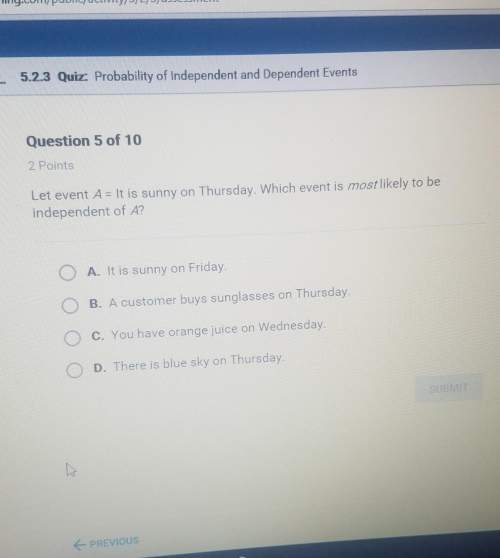
Answers: 1
Other questions on the subject: Mathematics

Mathematics, 21.06.2019 21:30, gonzalezashley152
In a test for esp (extrasensory perception), the experimenter looks at cards that are hidden from the subject. each card contains either a star, a circle, a wave, a cross or a square.(five shapes) as the experimenter looks at each of 20 cards in turn, the subject names the shape on the card. when the esp study described above discovers a subject whose performance appears to be better than guessing, the study continues at greater length. the experimenter looks at many cards bearing one of five shapes (star, square, circle, wave, and cross) in an order determined by random numbers. the subject cannot see the experimenter as he looks at each card in turn, in order to avoid any possible nonverbal clues. the answers of a subject who does not have esp should be independent observations, each with probability 1/5 of success. we record 1000 attempts. which of the following assumptions must be met in order to solve this problem? it's reasonable to assume normality 0.8(1000), 0.2(1000)%30 approximately normal 0.8(1000), 0.2(1000)% 10 approximately normal srs it is reasonable to assume the total number of cards is over 10,000 it is reasonable to assume the total number of cards is over 1000
Answers: 1

Mathematics, 21.06.2019 22:50, kristofwr3444
Use the quadratic function to predict f(x) if x equals 8. f(x) = 25x2 − 28x + 585
Answers: 1

Mathematics, 22.06.2019 00:30, dcttechgames
Simplify the given expression leaving the answer in improper fraction form. 2/3+5/6
Answers: 2

Mathematics, 22.06.2019 03:00, TheOriginalMeyah
The biologist has a second culture to examine. she knows that the population of the culture doubles every 15 minutes. after 1 hour and 15 minutes, her assistant found that 80,000 bacteria were present. a) what was the size of the initial population? b) predict the size of the culture at t=3 hours. what was the size of the population at 40 minutes? explain and justify your answers. c) create a graph of the population as a function of time. find an equation that can be used to predict the size of the population at any time t. d) examine the rate at which the bacteria culture is growing. how fast is the culture growing after 1 hour? after 1.5 hours? after 2 hours? use a time interval of h = 0.01 hours to estimate these rates. interpret these rates in terms of the context of the problem situation. how do these three rates compare?
Answers: 1
Do you know the correct answer?
How do you translate f(x) to get g(x)?...
Questions in other subjects:

History, 20.09.2019 15:10






Mathematics, 20.09.2019 15:10


Mathematics, 20.09.2019 15:10








